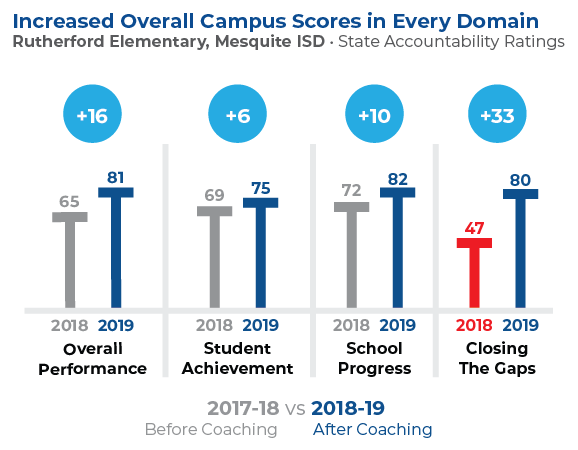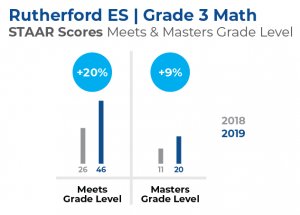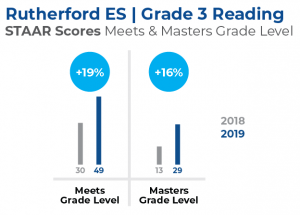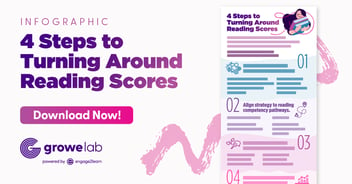The One-Year School Turnaround Story!
“Improvement Required” is undoubtedly the last place a school wants to find themselves.
To establish local accountability systems, the Texas State Legislature established three domains for academic performance in 2017:
- Student Achievement
- School Progress
- Closing the Gaps
Every year, the Texas Education Agency (TEA) issues school/district report cards with A-F ratings on each of the three performance domains based on state assessment results. And every year, educators anxiously wait to see if their hard work will make the grade or miss the mark.
For Mesquite ISD’s Rutherford Elementary, learning that they received “Improvement Required” in Domain 3, Closing the Gaps, came as a disappointing surprise.
When schools are identified as “Improvement Required” in any category, they are mandated to respond with improvement plans. In accordance with their plans, Mesquite ISD partnered with engage2learn (e2L) to provide job-embedded instructional coaching for 3rd-5th grade classroom teachers to support them in implementing high-quality Tier 1 Differentiated Instruction using the e2L Life Ready Best Practices. After being assigned to Rutherford as a teacher coach, I quickly learned that both teachers and administrators were putting in the work to determine why they had landed themselves in “Improvement Required” and what they needed to do to make sure it never happened again.
After analyzing the 2017-2018 student achievement data, Rutherford set three goals to lead their school improvement efforts. Each of their goals aligned to e2L’s job-embedded coaching on the Life Ready Best Practices. In turn, e2L's evidence-based coaching system served as the foundation for turning the school around. This one thing helped to ensure Rutherford wasn’t just adding another incentive or program to their teachers’ already overloaded plates.
Linking e2L Best Practices to School Goals
GOAL 1: Monitor student growth through formative assessments
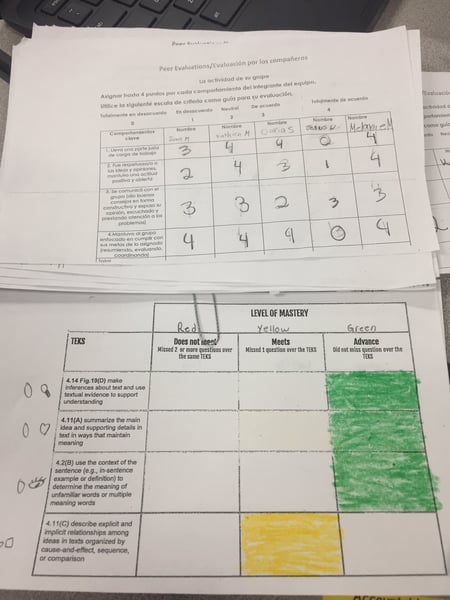 This goal naturally aligned to the e2L Assessment and Formative Feedback Best Practice standard. Instead of using PLC time or other meeting formats to relay information on properly assessing students, we were able to have meaningful, one-on-one collaborative discussions on the value of assessing students for growth and providing feedback.
This goal naturally aligned to the e2L Assessment and Formative Feedback Best Practice standard. Instead of using PLC time or other meeting formats to relay information on properly assessing students, we were able to have meaningful, one-on-one collaborative discussions on the value of assessing students for growth and providing feedback.
Through coaching, fourth grade math teacher Jessica Byrd realized the power of providing students with feedback: “For every formative assessment that students take, they’re going to chart their growth. That gives me the opportunity to look at that visual aid and that’s been fantastic for my students.”
Pre-assessments also became a key focus for 3rd-5th grade classrooms. Through coaching, teachers were able to see the wealth of data that pre-assessments provide and began using this data to add a more personalized approach to classroom teaching.
And it didn’t stop there! Teachers were finding ways to integrate technology into instruction by incorporating quick, real-time, standards-based digital assessments as checkpoints for student growth. Students were provided with their formative assessment information to track their personal gains, while teachers prepared individualized learning plans based on assessment data.
GOAL 2: Provide a personalized learning experience through differentiation
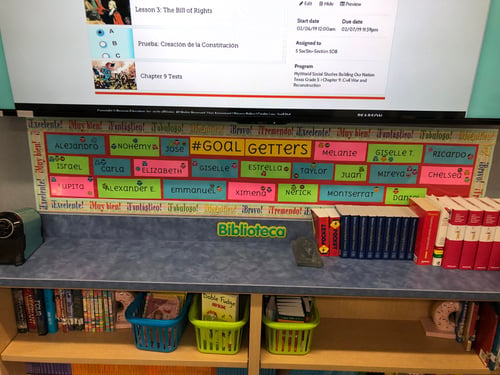 Many of the reading teachers were comfortable with facilitating instruction through small groups and providing leveled reading materials, but weren’t necessarily as confident in other content areas.
Many of the reading teachers were comfortable with facilitating instruction through small groups and providing leveled reading materials, but weren’t necessarily as confident in other content areas.
This is where coaching on e2L’s differentiation and scaffolding best practice helped to provide guidance and structure to support all grade levels and subject areas. Through modeling lessons, collaborating over ways to structure a classroom supportive of small group workshops and differentiation, and learning how to plan for and scaffold materials, teachers became more comfortable facilitating a differentiated classroom. In addition, rubrics were used to identify the students’ level of knowledge on a standard and were supported with resources and materials to personalize and further their learning.
This practice allowed teachers to provide a more personalized learning experience, which became a powerful tool in moving ALL students through content.
GOAL 3: Plan for high quality standard based lessons
The standards alignment best practice went hand-in-hand with Rutherford’s school goal to have every teacher understand the complexity of the Texas Essential Knowledge and Skills (TEKS). Professional development provider lead4ward was also working closely with Rutherford on this goal at that time, so effectively marrying the two was crucial.
Each week, teachers were given time to analyze standards and plan rigorous lessons to cover their content, and during coaching, we focused on lead4ward resources that supported their implementation of the TEKS. Unpacking the standards made it easier for them to create standard aligned assessment pieces and helped them plan relevant lessons.
Instructional Coaching for Growth
School administrators were understandably and rightfully protective of their teachers' time and workload. As the school coach, it was critical that my time spent with teachers through coaching conversations and classroom visits was regarded as valuable and relevant to teachers, rather than becoming yet another added initiative.
Each classroom teacher would receive three 1:1 coaching conversations, as well as three classroom visits, followed by a debrief. Rutherford’s administrative team was diligent in safeguarding the coaching relationship and preventing scheduling conflicts to maximize coaching time and effectiveness. If a conflict did arise, I was notified well in advance so that we could make appropriate changes to the schedule. In addition to protecting the coaching schedule, the schools' instructional coaches also attended coaching conversations to be able to better support teachers with available resources. Coaching conversations and classroom visits became non-negotiables, thus teacher growth in instructional best practices and competencies was evident. Each day concluded with a debrief with administrators to celebrate progress and collaborate on ways to support teachers in between coaching conversations.
The Impact of Teacher Coaching
When teachers reflected on personal and school growth, they identified teacher coaching as a critical tool in turning the school around. Academic growth wasn’t the only thing worth celebrating at Rutherford; administrators were noticing that teacher confidence was soaring, too. Rutherford’s Testing Coordinator Kristy Carter shared this:
“The difference that I see in our teachers that are being coached really is confidence. They’re meeting their goals and they’re seeing the fruits of their labor.”
Teachers were seeing that students could truly own their learning. Fourth grade teacher Dennice Bradford realized, “I don’t have to be the entertainer, where I stand up and I am the giver of the knowledge. Kids are being able to take on some of their own responsibilities which frees me up to be able to work with small groups.” Teachers agreed that students were more engaged in their work and they were growing in specific life skills, such as collaboration and communication.
Coaching Leads to Massive Gains in Student Achievement
By January, and after four short months of coaching, Rutherford’s students were showing growth on their district checkpoints. This helped provide extra motivation and momentum going into the spring semester as Rutherford teachers and administrators were determined to continue growth for ALL students, and the data was supporting their efforts.
After the first administration of 5th grade math and reading tests, the principal reported that they had 79% growth in math and 78% growth in reading – well above the district average for growth for their students.
When the final state assessment results arrived, Rutherford far exceeded their expectations, earning a “B” rating and “Met Expectations” in EVERY domain. Because of the support of the administrative team, their belief in the power of coaching, and the growth mindset of both the teachers and administrators, Rutherford Elementary cultivated a culture of success for all learners that will last for years to come.
RELATED: Measuring the Impact of e2L Coaching on Reading & Math Scores in Primary Grades
Rutherford Elementary Results
